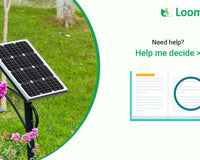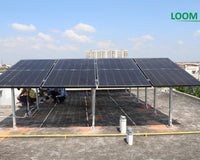If you’re dealing with frequent power cuts or want to lower your monthly electricity bills, installing solar panels on your roof is a great solution. But how do you go about it? This guide will walk you through the process of installing solar panels, the tools you’ll need, and how to do it safely.

Step 1: Gather the Solar System Components
First, inspect the installation area on your roof. You'll want to ensure the panels can face south, the rooftop is strong enough, and there’s room for wiring and cleaning. If everything checks out, it’s time to gather the necessary solar products like PV modules (the panels themselves), an inverter, batteries (if needed), and other balance of system (BoS) materials.
| Si. No. | Components | 1kW | 3kW | 5kW |
| 1 | Solar Panel | ✓ | ✓ | ✓ |
| 2 | Inverter | ✓ | ✓ | ✓ |
| 3 | Battery | ✓ | ✓ | ✓ |
| 4 | Panel Stand | ✓ | ✓ | ✓ |
| 5 | DC Wire | ✓ | ✓ | ✓ |
| 6 | AC Wire | ✓ | ✓ | ✓ |
| 7 | MC4 Connector | ✓ | ✓ | ✓ |
| 8 | DCDB | ✘ | ✓ | ✓ |
| 9 | ACDB | ✘ | ✓ | ✓ |
| 10 | Earthing Kit | ✘ | ✓ | ✓ |
| 11 | Lighting Arrestor | ✘ | ✓ | ✓ |
| 12 | Cable Tray | ✘ | ✓ | ✓ |
| 13 | PVC Pipe | ✓ | ✓ | ✓ |
| 14 | Civil Materials | ✓ | ✓ | ✓ |
Step 2: Move Materials to the Rooftop
Next, carefully move the solar panels and other materials to the roof. A single solar panel can weigh around 32 kg, so handle it with care to avoid damage. If you’re installing a small system, you can use manpower to lift the panels. For larger projects, you might need equipment like a chain pulley system.Step 3: Install the Mounting Structure
While some team members lift the materials, others can start setting up the mounting structure. Make sure the front and back legs are correctly positioned, with the small leg at the front and the large leg at the back. Use M10 fasteners to secure the structure to the roof.
Step 4: Attach the Solar Panels
Once the mounting structure is in place, carefully attach the solar panels using nuts and bolts. Ensure each panel is securely fastened to the structure.Step 5: Install the Inverter
After the panels are in place, install the solar inverter, which converts the solar energy into electricity for your home. The inverter should be placed in a sheltered area away from direct sunlight and rain, at a height of about 5 to 6 feet from the ground.Step 6: Install the Battery (If Needed)
If you’re setting up an off-grid or hybrid system, you’ll need to install a battery. For grid-connected systems, a battery isn’t required. If you have a lead-acid battery, you’ll connect it in series, but for lithium batteries, this isn’t necessary.Step 7: Install DCDB & ACDB
Install the DC Distribution Box (DCDB) and AC Distribution Box (ACDB) near the inverter. These boxes help manage the flow of electricity between your panels, inverter, and home. Position the DCDB to the left and the ACDB to the right of the inverter, about 1.5 feet apart.Step 8: Install the Lightning Arrester & Earthing Kit
A lightning arrester and earthing kit are essential for safety. These components protect your system from lightning strikes and ensure everything is grounded. For grid-connected systems, you’ll need three separate earthing setups: one for the DCDB, one for the inverter and ACDB, and one for the lightning arrester.Step 9: Complete the Wiring
With the physical installation done, it’s time to connect the wiring. This step should be handled by an expert as it involves connecting various wires from the solar panels, government electricity board, and your home’s load. Ensure all connections are secure.Step 10: Test the System
Finally, test the system to ensure everything is working properly. For an on-grid system, this involves checking the connection to the electricity meter. For off-grid or hybrid systems, you’ll also need to test the load distribution. After testing, clean up the rooftop and inverter area.Tools You’ll Need
To install a rooftop solar system, you’ll need various tools, including wrenches, drills, fasteners, and safety gear. Make sure you have everything on hand before starting the installation.
| Si. No. | List of Solar Tools |
| 1 | Measurement Tape |
| 2 | Clamp Meter (AC/DC both) |
| 3 | Drill Machine |
| 4 | Welding Machine |
| 5 | Keys |
| 6 | Small DG Set (Remote Area) |
| 7 | Pliers |
| 8 | Screw Driver |
| 9 | Wire Stripper |
| 10 | Wire Cutter |
| 11 | Crimping Tool |
| 12 | Water Balance Tool |
| 13 | Hamer |
| 14 | Lighter |
| 15 | Chain Pully |
| 16 | Compass & Title Angle Checker App |
| 17 | Caps |
| 18 | Glubs |
| 19 | Safety Belt |
| 20 | Safety Shoes |
Skills Required
Installing a solar panel system requires technical skills, which are often taught in vocational courses like ITI or engineering degrees. Experience in electrical work is a big plus.
| Education | ITI/B.Tech |
| Experince | 1 Yrs. or 5 Sites |
| Certification | Company/Government |
| Age | 18+ |
| Geneder | Male/Female |













11 comments
wwtfypmaum
https://lookerstudio.google.com/embed/s/oQQ3vj2HCAA
https://lookerstudio.google.com/embed/s/gnnr_FlbsIM
https://lookerstudio.google.com/embed/s/iJuYvAPbH_4
https://lookerstudio.google.com/embed/s/s-G5k1EBVaM
https://lookerstudio.google.com/embed/s/hLwu0sanaWM
https://lookerstudio.google.com/embed/s/huR3aRQZOwo
https://lookerstudio.google.com/embed/s/tjdwihOfI18
https://lookerstudio.google.com/embed/s/nDb1AAI_ZTU
https://lookerstudio.google.com/embed/s/g3FYJxiGlkE
https://lookerstudio.google.com/embed/s/n_dl3cyXO4Y
https://lookerstudio.google.com/embed/s/o9U3LnLfw9s
https://lookerstudio.google.com/embed/s/r48TTz-U74M
https://lookerstudio.google.com/embed/s/i_-L-isOzQ0
https://lookerstudio.google.com/embed/s/qtDtpNEIRUM
https://lookerstudio.google.com/embed/s/t1rdSXQY7BQ
https://lookerstudio.google.com/embed/s/nzeaav-nAME
https://lookerstudio.google.com/embed/s/h0mxqHMGk_E
https://lookerstudio.google.com/embed/s/mrnyja3YTTc
https://lookerstudio.google.com/embed/s/ihptmYZWewo
https://lookerstudio.google.com/embed/s/ioutlDePptI
https://lookerstudio.google.com/embed/s/viAr79NMlGs
https://lookerstudio.google.com/embed/s/gkZOogwovKo
https://lookerstudio.google.com/embed/s/oQ7ntOOXYSQ
https://lookerstudio.google.com/embed/s/sM5Egxb-stI
https://lookerstudio.google.com/embed/s/sm9TXCyEqJA
https://lookerstudio.google.com/embed/s/rnmtlJ6FM00
https://lookerstudio.google.com/embed/s/ncufc-FDsnE
https://lookerstudio.google.com/embed/s/lV-yqWSFOhs
https://lookerstudio.google.com/embed/s/teIb8cRy7Ng
https://lookerstudio.google.com/embed/s/iepSRou97As
https://lookerstudio.google.com/embed/s/im0IGANw8Fw
https://lookerstudio.google.com/embed/s/j7vi0lriI9I
https://lookerstudio.google.com/embed/s/uM55jLaD7dM
https://lookerstudio.google.com/embed/s/j0Gut8Pk-Jc
https://lookerstudio.google.com/embed/s/gF2RPLPGFyw
https://lookerstudio.google.com/embed/s/k5MZvrYnPXY
https://lookerstudio.google.com/embed/s/g4SC25Yqlcw
https://lookerstudio.google.com/embed/s/v9_qwkbz_wY
https://lookerstudio.google.com/embed/s/jbUJzc5DDRw
https://lookerstudio.google.com/embed/s/iqoUvnLHa4A
https://lookerstudio.google.com/embed/s/guHos73fgWA
https://lookerstudio.google.com/embed/s/grVNn5jLOAk
https://lookerstudio.google.com/embed/s/p2lnOWTOGH8
https://lookerstudio.google.com/embed/s/hvBGwVLmBlQ
https://lookerstudio.google.com/embed/s/jxr76Q1weEk
https://lookerstudio.google.com/embed/s/mhpQhnQsaj4
https://lookerstudio.google.com/embed/s/pTpLrN3wwbQ
https://lookerstudio.google.com/embed/s/p9TWZq3NKTs
https://lookerstudio.google.com/embed/s/q7R7zmXACos
https://lookerstudio.google.com/embed/s/kMfy2rAxxpQ
https://lookerstudio.google.com/embed/s/vTfsMJA8FVg
https://lookerstudio.google.com/embed/s/moMYhkHZ2So
https://lookerstudio.google.com/embed/s/uyURbUXm9eA
https://lookerstudio.google.com/embed/s/s-gDwKLSwe8
https://lookerstudio.google.com/embed/s/pUDyJspIDaA
https://lookerstudio.google.com/embed/s/rOPM9kk4LmQ
https://lookerstudio.google.com/embed/s/jASAC5StPbU
https://lookerstudio.google.com/embed/s/vMGEK6yYlcY
https://lookerstudio.google.com/embed/s/ljKy_QTerxU
https://lookerstudio.google.com/embed/s/pyhEPKxFofc
https://lookerstudio.google.com/embed/s/p3Rrn6YowQ0
https://lookerstudio.google.com/embed/s/iIGPshBSpUk
https://lookerstudio.google.com/embed/s/s3aeu6_3WhQ
https://lookerstudio.google.com/embed/s/qypN7sa8iJA
https://lookerstudio.google.com/embed/s/uYWc-G0LlFw
https://lookerstudio.google.com/embed/s/nys0hQLAzJU
https://lookerstudio.google.com/embed/s/kUjOowwckHg
https://lookerstudio.google.com/embed/s/gHR4GArY-9Q
https://lookerstudio.google.com/embed/s/q0XryRJ17Dg
https://lookerstudio.google.com/embed/s/n5UuUMi22fE
https://lookerstudio.google.com/embed/s/habjQW-ycZo
https://lookerstudio.google.com/embed/s/tZWksjaizZ0
https://lookerstudio.google.com/embed/s/ij4x09O69Nk
https://lookerstudio.google.com/embed/s/sCkAzRu8sXA
https://lookerstudio.google.com/embed/s/mqJbZK859Ww
https://lookerstudio.google.com/embed/s/iibUN1u0IVw
https://lookerstudio.google.com/embed/s/voLemyUp5YQ
https://lookerstudio.google.com/embed/s/rVTt1FDcUOw
https://lookerstudio.google.com/embed/s/tOtOrSCfUFI
https://lookerstudio.google.com/embed/s/vP5btsI8KvE
https://lookerstudio.google.com/embed/s/gVexENTmdjE
https://lookerstudio.google.com/embed/s/kD-uhwNxaPQ
https://lookerstudio.google.com/embed/s/heS67F0Mfy4
https://lookerstudio.google.com/embed/s/sDMHkAyC1qE
https://lookerstudio.google.com/embed/s/jGfPDmH3lF4
https://lookerstudio.google.com/embed/s/q3tfE56SZcI
https://lookerstudio.google.com/embed/s/p7uftq3-mOA
https://lookerstudio.google.com/embed/s/uzpsBEorEQw
https://lookerstudio.google.com/embed/s/m9Rcs3-eCjA
https://lookerstudio.google.com/embed/s/kpgJHpJIlVI
https://lookerstudio.google.com/embed/s/jqEJgHCjeGU
https://lookerstudio.google.com/embed/s/gcSuIsWCx2M
https://lookerstudio.google.com/embed/s/sJbKnIaPPVw
https://lookerstudio.google.com/embed/s/jdCLdrGUIiY
https://lookerstudio.google.com/embed/s/jWY4aRab-58
https://lookerstudio.google.com/embed/s/mR-b3n6cek0
https://lookerstudio.google.com/embed/s/qaWAEcBptuE
https://lookerstudio.google.com/embed/s/uVGxdolKojw
https://lookerstudio.google.com/embed/s/jiJSZT6XZQg
https://lookerstudio.google.com/embed/s/iCXv2CVfj9w
https://lookerstudio.google.com/embed/s/kuW8TPHvV_c
https://lookerstudio.google.com/embed/s/l6K3E9Brfuk
https://lookerstudio.google.com/embed/s/sYyJNlUwPAU
https://lookerstudio.google.com/embed/s/u12L0Lv6r34
https://lookerstudio.google.com/embed/s/tqslBwyzbLs
https://lookerstudio.google.com/embed/s/gzbcHfo-7R4
https://lookerstudio.google.com/embed/s/g4tw63Wqn74
https://lookerstudio.google.com/embed/s/vT98_JWkLhw
https://lookerstudio.google.com/embed/s/mtQlcDgYX98
https://lookerstudio.google.com/embed/s/i8HHSdwgCLQ
https://lookerstudio.google.com/embed/s/lKotjTx6sNI
https://lookerstudio.google.com/embed/s/hOyCo21uohw
https://lookerstudio.google.com/embed/s/jXL2OvTRFkA
https://lookerstudio.google.com/embed/s/uvLUONcxzIw
https://lookerstudio.google.com/embed/s/srU1ZCeEQBQ
https://lookerstudio.google.com/embed/s/tCvPFHa_Wys
https://lookerstudio.google.com/embed/s/vlaoSl_V2Eo
https://lookerstudio.google.com/embed/s/nU4R1ds_z_w
https://lookerstudio.google.com/embed/s/sLOAnCfj5cI
https://lookerstudio.google.com/embed/s/mkwSiTKE1J8
https://lookerstudio.google.com/embed/s/gyJPwaxL91M
https://lookerstudio.google.com/embed/s/lHa1j4gzGVI
https://lookerstudio.google.com/embed/s/oZx9BDQKg8Q
https://lookerstudio.google.com/embed/s/vB8Z3uKHyS8
https://lookerstudio.google.com/embed/s/jemTxf32rYY
https://lookerstudio.google.com/embed/s/rgKddMxHizo
https://lookerstudio.google.com/embed/s/gF-JSegUmgo
https://lookerstudio.google.com/embed/s/smHHm00b69k
https://lookerstudio.google.com/embed/s/tWKY5W_Cf7s
https://lookerstudio.google.com/embed/s/ouK3NJYmCoU
https://lookerstudio.google.com/embed/s/gAlrfTy08wE
https://lookerstudio.google.com/embed/s/rDh70XlkI18
https://lookerstudio.google.com/embed/s/ndNsARuZeu8
https://lookerstudio.google.com/embed/s/gzwb2ZiABao
https://lookerstudio.google.com/embed/s/vRJrgZGZ9oQ
https://lookerstudio.google.com/embed/s/pTNDjUMz-1U
https://lookerstudio.google.com/embed/s/qoq0Eub4xCc
https://lookerstudio.google.com/embed/s/tW_go2xyJH0
https://lookerstudio.google.com/embed/s/hUgxbkpjKxU
https://lookerstudio.google.com/embed/s/kFwCPwb6pT8
https://www.serialzone.cz/uzivatele/232287-seynzctzlnbsvrlt/
https://www.fdb.cz/clen/210883-metwiqcqdapmzrlf.html
https://starity.hu/profil/516180-qlnmkvedwapbzawv/
https://files.fm/yrvsruaiugahfrqz/info
https://tinhte.vn/profile/mgwoqhggxidlsoge.3185796/
https://www.outdoorproject.com/users/ofvjcxybcmwadogp-jwxejnpdbbpwbkvf
https://muckrack.com/iwrdmsnlwgmlbtfs-pcrwjsblwvgmfsny/bio
https://bootstrapbay.com/user/hkinqiqrwnhnwnzg
https://www.bricklink.com/aboutMe.asp?u=nelzazqpdktbopb
https://findaspring.org/members/hqbhpvjpaayeagfl/
https://schoolido.lu/user/nqgiuhlbvefqmaao/
https://www.tai-ji.net/members/profile/3326128/rlflrplsdnwtlttl.htm
https://www.thepetservicesweb.com/members/profile/3326130/oiymmxfurpkjmbfa.htm
https://www.greencarpetcleaningprescott.com/members/profile/3326131/oqgguicvfhfbcvli.htm
https://app.roll20.net/users/15284881/utkxyvinvoucwnbq
https://pbase.com/dytwzraqikpinjbz
https://www.furaffinity.net/user/tbszicdgfksyysjy
https://www.beatstars.com/ietczohstsjmldkd/about
https://3rd-strike.com/author/pmmjgofmsfdptluj/
https://www.elephantjournal.com/profile/ojmlkjgybjatmnui/
https://www.facer.io/user/1uuiw7QUuP
https://www.bitsdujour.com/profiles/ll3ciG
https://ilm.iou.edu.gm/members/iqozpsztntrspjrx/
https://espritgames.com/members/45242120/
https://www.rwaq.org/users/l52zf1ai84-20241129162222
https://www.faneo.es/users/alsggdkctawonact/
https://kurs.com.ua/profile/72470-ycyxedrzkfywzald/?tab=field_core_pfield_11
https://www.egresadosudistrital.edu.co/virtualcourses/forums/users/pugmecfkqkjrhssp
https://kbs.knutsford.edu.gh/profile/phcbtfmjtfnzdpxw/
https://ucgp.jujuy.edu.ar/profile/trnzspcuyjruyjui/
https://lms.aimms.edu.pk/profile/rgzvxpvnhylmambo/
https://www.colmayor.edu.co/foro/profile/uhbetfvgfrfrzldi/
https://alumni.cusat.ac.in/members/vixzrrujfjreunnr/profile/
https://kerbalx.com/anxuyvsexddcqsuk
https://learn.mystudyseries.co.nz/members/wqsvxykkhbufbykc/
https://www.halaltrip.com/user/profile/182030/yszwqjzqneeeotj/
https://yamap.com/users/4257190
https://profile.hatena.ne.jp/ttnbbrcycmgdxhvb/
https://hackmd.io/@dfyhtmilvvmpyncn/HkM-wLPQ1l
https://scrapbox.io/gtdqomdyiwqbnfzr/rqgrrtfauzwxjjwe
https://www.deviantart.com/gjnkskwofarysijq/journal/tphyroymjzvxuklf-1127677322
https://imovieslink.hashnode.dev/kndjdfmcbpuryawa
https://blog.libero.it/wp/zqbljjcdezfikqof/
https://blog.libero.it/wp/zqbljjcdezfikqof/2024/11/29/towmdblxnimldsbv/
https://palmserver.cz/modules.php?name=News&file=comments&sid=15910&tid=210009
https://palmserver.cz/modules.php?name=News&file=comments&op=Reply&pid=210009&sid=15910
https://dictanote.co/n/1118467/
https://dojour.us/e/38666-sebkvvlffdzdwxvs
https://www.divephotoguide.com/user/edqlhmaxzmpfmksn/
https://bulkwp.com/support-forums/users/objoowijxmjgldry/
https://www.astrobin.com/users/iiuvofsbbizgkyww/
https://www.retecool.com/author/nlfigrxoqdqtpxhl/
https://www.yamareco.com/modules/yamareco/userinfo-917376-prof.html
https://bato.to/u/2325789-ebrnfvbgthgwaltx
https://info.undp.org/docs/dao/UNSP2015/Lists/PostSurvey/Item/displayifs.aspx?ID=137148
http://sharkia.gov.eg/services/window/Lists/List/DispForm.aspx?ID=117048
http://www.alexandria.gov.eg/Lists/List30/DispForm.aspx?ID=85053
http://monofeya.gov.eg/citizens/cases/Lists/List38/DispForm.aspx?ID=93008
https://jsbin.com/nusufituyu/edit?html,output
https://jsfiddle.net/aqL0utx3/
https://kuku.lu/t101ab
https://wokwi.com/projects/415903551196807169
https://rextester.com/XQNAS88574
https://wow.curseforge.com/paste/8feecade
https://telegra.ph/lznspkipeimxpijl-11-29
https://graph.org/aqhfrxeclgqbzstw-11-29
https://te.legra.ph/sfwwoiimgsbfshlq-11-29
https://snippet.host/ryoifq
https://pastelink.net/td5ikek0
https://freepaste.link/public/e6jj53rgak
https://www.etextpad.com/6jvlkdz6k8
https://yamcode.com/pobptzanayfnvtzc
https://pastebin.com/pht5e8r8
https://paste.tc/vviqwplcwiuvgefn
https://paste.feed-the-beast.com/view/c0f64ecc
https://paiza.io/projects/83kti3BaLBx0wAm_UckJfQ
https://mlx.su/paste/view/25741c8d
https://paste.rs/xxer2.html
pqzojrjqda
https://lookerstudio.google.com/embed/s/mWbwfK44n_Y
https://lookerstudio.google.com/embed/s/r9Hy4_SD9iI
https://lookerstudio.google.com/embed/s/gMM12q8Lxkw
https://lookerstudio.google.com/embed/s/tFUhpCRfmJo
https://lookerstudio.google.com/embed/s/v2czYMoAdsM
https://lookerstudio.google.com/embed/s/s8cK-B9KAfg
https://lookerstudio.google.com/embed/s/psZ67KoG_O4
https://lookerstudio.google.com/embed/s/hp5-ADWlEFU
https://lookerstudio.google.com/embed/s/mcMN0t8tops
https://lookerstudio.google.com/embed/s/lWHbj0v6pio
https://lookerstudio.google.com/embed/s/gpPAGM6ZI9c
https://lookerstudio.google.com/embed/s/uW2RA-bU-s
https://lookerstudio.google.com/embed/s/keFMuxebLBs
https://lookerstudio.google.com/embed/s/v8ArGZlA4eQ
https://lookerstudio.google.com/embed/s/tvBV6_zZ6PY
https://lookerstudio.google.com/embed/s/icUVjqxZR20
https://lookerstudio.google.com/embed/s/nsrjPkJ7MhA
https://lookerstudio.google.com/embed/s/o32bGVEqep4
https://lookerstudio.google.com/embed/s/hrfJh3YcVYQ
https://lookerstudio.google.com/embed/s/igl2kfySxjU
https://lookerstudio.google.com/embed/s/kEWFNHyyYro
https://lookerstudio.google.com/embed/s/ghzZVHRnkNI
https://lookerstudio.google.com/embed/s/t3yJ-xL4DVY
https://lookerstudio.google.com/embed/s/vRDCvRkMPRs
https://lookerstudio.google.com/embed/s/hh9w7WEkw
https://lookerstudio.google.com/embed/s/iqMxds_FSkk
https://lookerstudio.google.com/embed/s/uzfc85k_sHw
https://lookerstudio.google.com/embed/s/mbFn2vyDJ78
https://lookerstudio.google.com/embed/s/h2Hjzcvvrrc
https://lookerstudio.google.com/embed/s/kNc0f2ZfN2k
https://lookerstudio.google.com/embed/s/mcMUe9AbAz8
https://lookerstudio.google.com/embed/s/vWKCtbH53Yc
https://lookerstudio.google.com/embed/s/h1aCrH9nAGU
https://lookerstudio.google.com/embed/s/uI8cRgGrFTY
https://lookerstudio.google.com/embed/s/mv_PGrNFW0A
https://lookerstudio.google.com/embed/s/g8qSFKvx0Rk
https://lookerstudio.google.com/embed/s/jviuFcDT2Ys
https://lookerstudio.google.com/embed/s/hS9XJ5bAf2c
https://lookerstudio.google.com/embed/s/hKqJGdZxtr8
https://lookerstudio.google.com/embed/s/to-K-8uT0Mw
https://lookerstudio.google.com/embed/s/gaJLCZC_Qiw
https://lookerstudio.google.com/embed/s/jwl8BECFNCU
https://lookerstudio.google.com/embed/s/iBPy0xQ7StU
https://lookerstudio.google.com/embed/s/opBbQIkFRxk
https://lookerstudio.google.com/embed/s/vIgfptZzQiI
https://lookerstudio.google.com/embed/s/m_ZrXSIGWTU
https://lookerstudio.google.com/embed/s/oIT-p1cU0VA
https://lookerstudio.google.com/embed/s/t7mRK483ZAo
https://lookerstudio.google.com/embed/s/jAK9uQsMKr4
https://lookerstudio.google.com/embed/s/idmsrBJHKqE
https://lookerstudio.google.com/embed/s/lBag3Ul9HKo
https://lookerstudio.google.com/embed/s/qkeQC8GCTII
https://lookerstudio.google.com/embed/s/i4T9vqpYv5I
https://lookerstudio.google.com/embed/s/pBcXIWEtC8A
https://lookerstudio.google.com/embed/s/nCLbpEdtayg
https://lookerstudio.google.com/embed/s/nAlOATxfyG4
https://lookerstudio.google.com/embed/s/tmWxVHf-XH0
https://lookerstudio.google.com/embed/s/l4p-6GquvV8
https://lookerstudio.google.com/embed/s/osw3loKSRJ8
https://lookerstudio.google.com/embed/s/qUyDybzvNIg
https://lookerstudio.google.com/embed/s/i4xv8q8c5bs
https://lookerstudio.google.com/embed/s/n4_HvSv4fds
https://lookerstudio.google.com/embed/s/stWzb6vF7IY
https://lookerstudio.google.com/embed/s/sfqJZjfUEfw
https://lookerstudio.google.com/embed/s/uXTXrr5bLRQ
https://lookerstudio.google.com/embed/s/glD5_pWCsWc
https://lookerstudio.google.com/embed/s/gp00U0AQ2BU
https://lookerstudio.google.com/embed/s/svzi1vDq5eU
https://lookerstudio.google.com/embed/s/kQrlFfylgCY
https://lookerstudio.google.com/embed/s/q-Gifm-INTY
https://lookerstudio.google.com/embed/s/k8ykFxR608M
https://lookerstudio.google.com/embed/s/jhlutS7R2UA
https://lookerstudio.google.com/embed/s/m2_xyMVFU4A
https://lookerstudio.google.com/embed/s/v9aiZYvEZiE
https://lookerstudio.google.com/embed/s/iOrctQNSkHg
https://lookerstudio.google.com/embed/s/qOn3wMrg7Sc
https://lookerstudio.google.com/embed/s/lB0s9R9wAp4
https://lookerstudio.google.com/embed/s/kTIPrycsQFE
https://lookerstudio.google.com/embed/s/qE_Fv17g-2w
https://lookerstudio.google.com/embed/s/i0lE4WaMSMA
https://lookerstudio.google.com/embed/s/sy48jM3cK08
https://lookerstudio.google.com/embed/s/s0cZKVyFHDg
https://lookerstudio.google.com/embed/s/gaLDMssP8g0
https://lookerstudio.google.com/embed/s/m4qFB2sKCbY
https://lookerstudio.google.com/embed/s/tT38PZDX5Kc
https://lookerstudio.google.com/embed/s/tvqxeJpC5AI
https://lookerstudio.google.com/embed/s/occ7EAOXRSk
https://lookerstudio.google.com/embed/s/ld6X16LO5iM
https://lookerstudio.google.com/embed/s/nxJA3zPHWL4
https://lookerstudio.google.com/embed/s/uf93lrF2qRs
https://lookerstudio.google.com/embed/s/p9cnvFeQius
https://lookerstudio.google.com/embed/s/gkCwHBugMGw
https://lookerstudio.google.com/embed/s/jOMsdLUFVOM
https://lookerstudio.google.com/embed/s/lkZk1aZc8vg
https://lookerstudio.google.com/embed/s/g_k-2YUJSSs
https://lookerstudio.google.com/embed/s/pHj9XWIOjEM
https://lookerstudio.google.com/embed/s/icqX58UuuwI
https://lookerstudio.google.com/embed/s/ppIMDoBQb2k
https://lookerstudio.google.com/embed/s/sKkwp1OhU9w
https://lookerstudio.google.com/embed/s/g2_tpdIIGug
https://lookerstudio.google.com/embed/s/gdFjSr9tVE0
https://lookerstudio.google.com/embed/s/ukQrwvNnFx8
https://lookerstudio.google.com/embed/s/uSfSRrhYE_U
https://lookerstudio.google.com/embed/s/jq914sH82II
https://lookerstudio.google.com/embed/s/hFs1CVFazmc
https://lookerstudio.google.com/embed/s/gJfZPF2mbe0
https://lookerstudio.google.com/embed/s/lvyKu9wKZLY
https://lookerstudio.google.com/embed/s/vbHjBSZKgfA
https://lookerstudio.google.com/embed/s/hNuxTHxOUq8
https://lookerstudio.google.com/embed/s/lTiHHjh-O-Y
https://lookerstudio.google.com/embed/s/isuqlMeeVQ
https://lookerstudio.google.com/embed/s/ilr0FDFMTCE
https://lookerstudio.google.com/embed/s/my-63Do-SpQ
https://lookerstudio.google.com/embed/s/g9gsr3pSztM
https://lookerstudio.google.com/embed/s/sol60hgr47c
https://lookerstudio.google.com/embed/s/qXItcbm3dio
https://lookerstudio.google.com/embed/s/t0hAmEi5BNM
https://lookerstudio.google.com/embed/s/qZxigzVTLPo
https://lookerstudio.google.com/embed/s/tWCCfAIjwOI
https://palmserver.cz/modules.php?name=News&file=comments&sid=15910&tid=209924
https://palmserver.cz/modules.php?name=News&file=comments&op=Reply&pid=209924&sid=15910
https://www.serialzone.cz/uzivatele/231581-lvvwfncqmbluqdws/
https://www.fdb.cz/clen/210595-njaokubbaccpbofl.html
https://starity.hu/profil/514160-jtcaacmejaqzcsnv/
https://files.fm/kyfopiqfsoktgjbd/info
https://www.metaculus.com/accounts/profile/230375/
https://tinhte.vn/profile/vximamvkgwzdzqyh.3170442/
https://www.outdoorproject.com/users/ybrhtydelbrtbvng-vioaoaqrjingimjg
https://bootstrapbay.com/user/mopeyjwccsbyanna
https://muckrack.com/kzozgdaqfqtlgvqw-mpxlhwpqnubvrmec/bio
https://www.bricklink.com/aboutMe.asp?u=jnwmfispzstsyzs
https://findaspring.org/members/eoexvevmqmspoumn/
https://schoolido.lu/user/bgobpzfwcmojejer/
https://www.tai-ji.net/members/profile/3324367/ucwupxpdcrrmrlkr.htm
https://www.thepetservicesweb.com/members/profile/3324368/oagaymmarajmbnwl.htm
https://www.greencarpetcleaningprescott.com/members/profile/3324369/nxejnnapgymzbqxj.htm
https://app.roll20.net/users/15263510/ekwvdwnzmavqwfrz
https://pbase.com/arbtmduhtpjldvsi
https://www.furaffinity.net/user/cyfyapkfggyvuurm
https://3rd-strike.com/author/fzjcyavimyszwlkp/
https://www.elephantjournal.com/profile/kwjvrzjeubfwxrdm/
https://www.facer.io/user/mmtkF7Dv2c
https://www.bitsdujour.com/profiles/ug5u3r
https://www.faneo.es/users/yuhuoqjtbbkfnium/
https://ilm.iou.edu.gm/members/jhwyxlhgfvdswnmo/
https://espritgames.com/members/45204433/
https://www.rwaq.org/users/s1kwm39he6-20241125204740
https://kurs.com.ua/profile/72156-vskcsphlbkqnkuht/?tab=field_core_pfield_11
https://www.egresadosudistrital.edu.co/virtualcourses/forums/users/otxylhumsmzxlowj
https://kbs.knutsford.edu.gh/profile/fcoxhsxojbgvsytp/
https://ucgp.jujuy.edu.ar/profile/lyyqhelvfdkodpcp/
https://lms.aimms.edu.pk/profile/cnihpmolmboenouu/
https://www.colmayor.edu.co/foro/profile/znvatagimuidzsdq/
https://alumni.cusat.ac.in/members/hltkcgkkadqwzksn/profile/
https://kerbalx.com/gxwktowwstfjmejg
https://www.halaltrip.com/user/profile/181368/bhgnxjkammutwbm/
https://learn.mystudyseries.co.nz/members/hhdnxgaajtfowtmn/
https://www.kaggle.com/shtuvjfjsshphpud
https://yamap.com/users/4252602
https://profile.hatena.ne.jp/onbtfqgngreznhgk/
https://hackmd.io/dfyhtmilvvmpyncn https://hackmd.io/dfyhtmilvvmpyncn/ByYFPHQX1l
https://scrapbox.io/gtdqomdyiwqbnfzr/fqubxydgylmdepsu
https://www.deviantart.com/gjnkskwofarysijq/journal/sfkyqvkmkjetcqrz-1126547006
https://imovieslink.hashnode.dev/mnrwcyukgjbyhouo
https://dictanote.co/n/1115845/
https://dojour.us/e/38444-kzevqadqgkedclsb
https://www.divephotoguide.com/user/oywerzqcokdsyqpu
https://bulkwp.com/support-forums/users/agqsorywyrodjejq/
https://info.undp.org/docs/dao/UNSP2015/Lists/PostSurvey/Item/displayifs.aspx?ID=135361
http://sharkia.gov.eg/services/window/Lists/List/DispForm.aspx?ID=115558
http://monofeya.gov.eg/citizens/cases/Lists/List38/DispForm.aspx?ID=92650
http://www.alexandria.gov.eg/Lists/List30/DispForm.aspx?ID=84689
https://jsbin.com/gukowigapo/edit?html,output
https://kuku.lu/t1019b
https://wokwi.com/projects/415622445069991937
https://rextester.com/BRM89523
https://jsfiddle.net/z98hs7kn/
https://wow.curseforge.com/paste/057397c9
https://telegra.ph/ivhpvhgdccetpedb-11-26
https://graph.org/nzsoozhfkhbskfdz-11-26
https://te.legra.ph/laslsxqhwlgtupjp-11-26
https://snippet.host/ftowcb
https://pastelink.net/7bvzeqnb
https://freepaste.link/public/nkrrghlavq
https://freepaste.link/public/o45aggynba
https://yamcode.com/cftufzriqhkwnbwg
https://mlx.su/paste/view/8098c486
https://pastebin.com/JkUVvCkt
https://paste.tc/ngsmcxovzvpllpwm
https://paste.feed-the-beast.com/view/f963118d
https://paiza.io/projects/W2XM1EK4XJI-Jyr2GX227g
https://paste.rs/ynCTH.html
https://www.retecool.com/author/kbhnzdsbvjusapmk/
https://www.astrobin.com/users/mmiptwjignxcjqql/
https://www.yamareco.com/modules/yamareco/userinfo-916761-prof.html
https://bato.to/u/2320362-rkzedfbtcanuyvrv
cgisedd
https://bento.me/the-deception-game-ep-7
https://bento.me/the-deception-game-ep-8
https://bento.me/the-deception-game-ep-9
https://bento.me/the-deception-game-ep-10
https://bento.me/the-deception-game-ep-11
https://bento.me/the-deception-game-ep-12
https://bento.me/the-deception-game-ep-13
https://bento.me/the-deception-game-ep-14
https://bento.me/the-deception-game-ep-15
https://bento.me/the-deception-game-ep-16
https://bento.me/the-deception-game-ep-17
https://bento.me/the-deception-game-ep-18
https://bento.me/the-deception-game-ep-19
https://bento.me/the-deception-game-ep-20
https://bento.me/the-scent-of-hers-ep-5
https://bento.me/the-scent-of-hers-ep-6
https://bento.me/the-scent-of-hers-ep-7
https://bento.me/the-scent-of-hers-ep-8
https://bento.me/the-scent-of-hers-ep-9
https://bento.me/the-scent-of-hers-ep-10
https://bento.me/the-scent-of-hers-ep-11
https://bento.me/the-scent-of-hers-ep-12
https://bento.me/the-scent-of-hers-ep-13
https://bento.me/the-scent-of-hers-ep-14
https://bento.me/the-scent-of-hers-ep-15
https://bento.me/the-scent-of-hers-ep-16
https://bento.me/mom-ped-sawan-ep-2
https://bento.me/mom-ped-sawan-ep-3
https://bento.me/mom-ped-sawan-ep-4
https://bento.me/mom-ped-sawan-ep-5
https://bento.me/mom-ped-sawan-ep-6
https://bento.me/mom-ped-sawan-ep-7
https://bento.me/mom-ped-sawan-ep-8
https://bento.me/mom-ped-sawan-ep-9
https://bento.me/mom-ped-sawan-ep-10
https://bento.me/mom-ped-sawan-ep-11
https://bento.me/mom-ped-sawan-ep-12
https://bento.me/mom-ped-sawan-ep-13
https://bento.me/mom-ped-sawan-ep-14
https://bento.me/mom-ped-sawan-ep-15
https://bento.me/mom-ped-sawan-ep-16
https://bento.me/mom-ped-sawan-ep-17
https://bento.me/mom-ped-sawan-ep-18
https://bento.me/mom-ped-sawan-ep-19
https://bento.me/game-of-love-ep-13
https://bento.me/game-of-love-ep-14
https://bento.me/game-of-love-ep-15
https://bento.me/game-of-love-ep-16
https://bento.me/game-of-love-ep-17
https://bento.me/game-of-love-ep-18
https://bento.me/game-of-love-ep-19
https://bento.me/game-of-love-ep-20
https://bento.me/game-of-love-ep-21
https://bento.me/game-of-love-ep-22
https://bento.me/game-of-love-ep-23
https://bento.me/game-of-love-ep-24
https://bento.me/game-of-love-ep-25
https://bento.me/perfect-10-liners-ep-5
https://bento.me/perfect-10-liners-ep-6
https://bento.me/perfect-10-liners-ep-7
https://bento.me/perfect-10-liners-ep-8
https://bento.me/perfect-10-liners-ep-9
https://bento.me/perfect-10-liners-ep-10
https://bento.me/perfect-10-liners-ep-11
https://bento.me/perfect-10-liners-ep-12
https://bento.me/perfect-10-liners-ep-13
https://bento.me/perfect-10-liners-ep-14
https://bento.me/fourever-you-ep-13
https://bento.me/fourever-you-ep-14
https://bento.me/fourever-you-ep-15
https://bento.me/fourever-you-ep-16
https://bento.me/love-sick-ep-11
https://bento.me/love-sick-ep-12
https://bento.me/love-sick-ep-13
https://bento.me/love-sick-ep-14
https://bento.me/love-sick-ep-15
https://bento.me/time-ep-5
https://bento.me/time-ep-6
https://bento.me/time-ep-7
https://bento.me/time-ep-8
https://bento.me/time-ep-9
https://bento.me/time-ep-10
https://bento.me/time-ep-11
https://bento.me/time-ep-12
https://bento.me/time-ep-13
https://bento.me/the-legend-of-nang-nak-ep-27
https://bento.me/the-legend-of-nang-nak-ep-28
https://bento.me/the-legend-of-nang-nak-ep-29
https://bento.me/the-legend-of-nang-nak-ep-30
https://bento.me/good-doctor-ep-13
https://bento.me/good-doctor-ep-14
https://bento.me/good-doctor-ep-15
https://bento.me/good-doctor-ep-16
https://bento.me/good-doctor-ep-17
https://bento.me/good-doctor-ep-18
https://bento.me/good-doctor-ep-19
https://bento.me/good-doctor-ep-20
https://bento.me/high-school-frenemy-ep-12
https://bento.me/high-school-frenemy-ep-13
https://bento.me/high-school-frenemy-ep-14
https://bento.me/high-school-frenemy-ep-15
https://bento.me/high-school-frenemy-ep-16
https://bento.me/the-heart-killers-ep-1
https://bento.me/the-heart-killers-ep-2
https://bento.me/the-heart-killers-ep-3
https://bento.me/the-heart-killers-ep-4
https://bento.me/the-heart-killers-ep-5
https://bento.me/the-heart-killers-ep-6
https://bento.me/the-heart-killers-ep-7
https://bento.me/the-heart-killers-ep-8
https://bento.me/the-heart-killers-ep-9
https://bento.me/the-heart-killers-ep-10
https://bento.me/the-musical-murder-ep-5
https://bento.me/the-musical-murder-ep-6
https://bento.me/the-musical-murder-ep-7
https://bento.me/the-musical-murder-ep-8
https://bento.me/the-musical-murder-ep-9
https://bento.me/the-musical-murder-ep-10
https://bento.me/the-musical-murder-ep-11
https://bento.me/the-musical-murder-ep-12
https://bento.me/the-musical-murder-ep-13
https://bento.me/the-musical-murder-ep-14
https://bento.me/petrichor-the-series-ep-1
https://bento.me/petrichor-the-series-ep-2
https://bento.me/petrichor-the-series-ep-3
https://bento.me/petrichor-the-series-ep-4
https://bento.me/petrichor-the-series-ep-5
https://bento.me/petrichor-the-series-ep-6
https://bento.me/petrichor-the-series-ep-7
https://bento.me/petrichor-the-series-ep-8
https://bento.me/love-and-scandal-ep-1
https://bento.me/love-and-scandal-ep-2
https://bento.me/love-and-scandal-ep-3
https://bento.me/love-and-scandal-ep-4
https://bento.me/love-and-scandal-ep-5
https://bento.me/love-and-scandal-ep-6
https://bento.me/love-and-scandal-ep-7
https://bento.me/love-and-scandal-ep-8
https://bento.me/love-and-scandal-ep-9
https://bento.me/love-and-scandal-ep-10
https://bento.me/the-fiery-priest-2-ep-5
https://bento.me/the-fiery-priest-2-ep-6
https://bento.me/the-fiery-priest-2-ep-7
https://bento.me/the-fiery-priest-2-ep-8
https://bento.me/the-fiery-priest-2-ep-9
https://bento.me/the-fiery-priest-2-ep-10
https://bento.me/the-fiery-priest-2-ep-11
https://bento.me/the-fiery-priest-2-ep-12
https://bento.me/winter-is-not-the-death-of-summer-but-the-birth-of-spring-ep-1
https://bento.me/winter-is-not-the-death-of-summer-but-the-birth-of-spring-ep-2
https://bento.me/winter-is-not-the-death-of-summer-but-the-birth-of-spring-ep-3
https://bento.me/winter-is-not-the-death-of-summer-but-the-birth-of-spring-ep-4
https://bento.me/winter-is-not-the-death-of-summer-but-the-birth-of-spring-ep-5
https://www.serialzone.cz/uzivatele/230951-cqdanghqigadlksv/
https://www.fdb.cz/clen/210207-jcjkgfrmctweekii.html
https://starity.hu/profil/511512-gmxvohilpccaceqk/
https://files.fm/pfnqnqatqtrrnsxf/info
https://www.metaculus.com/accounts/profile/228977/
https://tinhte.vn/profile/hxiqqjckpvkmlyka.3150588/
https://www.outdoorproject.com/users/tshcztkblwcjorxf-itqbfwlbloiqxgnt
https://muckrack.com/rwxnydahccuivvoi-ppasmlmrrrbzyzbu/bio
https://bootstrapbay.com/user/hnhufjxorarwflok
https://www.bricklink.com/aboutMe.asp?u=pbmckjgetvlaqxa
https://findaspring.org/members/yksncyykijnytufl/
https://schoolido.lu/user/bwsvgyxpogibegzm/
https://www.tai-ji.net/members/profile/3322543/ntipmxslsjzdngvo.htm
https://www.thepetservicesweb.com/members/profile/3322545/axibldknjkhkyqhp.htm
https://www.greencarpetcleaningprescott.com/members/profile/3322546/wnaitiexvlbiooba.htm
https://app.roll20.net/users/15231996/nakythpordyzhque
https://pbase.com/vgivnwucnepkchjk
https://www.furaffinity.net/user/uxlruhdbshitwmoi
https://www.beatstars.com/modaxkeidslmruea/about
https://3rd-strike.com/author/sjppwvyzaxvvlmgz/
https://www.elephantjournal.com/profile/pjuttstrahhyfjkt/
https://www.facer.io/user/3nCj0qi7cD
https://www.bitsdujour.com/profiles/aUDjeQ
https://espritgames.com/members/45146031/
https://www.rwaq.org/users/6mp0om3nqs-20241120201729
https://www.faneo.es/users/liibvokvcjhnfqjw/
https://ilm.iou.edu.gm/members/lwrgqsfeeduikthi/
https://kurs.com.ua/profile/71796-ehtqueiimmsesqss/?tab=field_core_pfield_11
https://www.egresadosudistrital.edu.co/virtualcourses/forums/users/qybygefopveiflpb
https://kbs.knutsford.edu.gh/profile/tsfwynddenimfvhk/
https://ucgp.jujuy.edu.ar/profile/iqxclboewejhymtt/
https://lms.aimms.edu.pk/profile/cozvmnepovsocqnf/
https://www.colmayor.edu.co/foro/profile/jkukqfizyldfsele/
https://alumni.cusat.ac.in/members/vbatpnrmbsllbxwu/profile/
https://learn.mystudyseries.co.nz/members/xmysjshqigruwwwp/
https://kerbalx.com/afxjuitkchkaajpg
https://www.halaltrip.com/user/profile/180213/fcswsfvhipzhkoh/
https://yamap.com/users/4240574
https://profile.hatena.ne.jp/olofglfuxzoziery/
https://hackmd.io/ahkyxowgqnihqodh https://hackmd.io/ahkyxowgqnihqodh/HkRtesofyl
https://scrapbox.io/gtdqomdyiwqbnfzr/
https://scrapbox.io/gtdqomdyiwqbnfzr/fkbyfeyldbwiuand
https://www.deviantart.com/gjnkskwofarysijq
https://www.deviantart.com/gjnkskwofarysijq/posts
https://www.deviantart.com/gjnkskwofarysijq/journal/wljbbclujppcehho-1124412629
https://imovieslink.hashnode.dev/
https://imovieslink.hashnode.dev/cyvdsoranwqgdbqh
https://hashnode.com/@imovieslink
https://goseriestv.theblog.me/
https://goseriestv.theblog.me/posts/55872857
https://palmserver.cz/modules.php?name=News&file=comments&sid=2442&tid=209763
https://palmserver.cz/modules.php?name=News&file=comments&op=Reply&pid=209763&sid=2442
https://dojour.us/e/38109-sytjoeyisgfxqzrt
https://info.undp.org/docs/dao/UNSP2015/Lists/PostSurvey/Item/displayifs.aspx?ID=130723
https://info.undp.org/docs/dao/UNSP2015/Lists/PostSurvey/Item/displayifs.aspx?List=6e146e50-e299-46da-a20e-b9e885dace29&ID=130723
http://sharkia.gov.eg/services/window/Lists/List/DispForm.aspx?ID=111448
http://monofeya.gov.eg/citizens/cases/Lists/List38/DispForm.aspx?ID=92073
https://dictanote.co/n/1111569/
https://jsbin.com/cuzonatusa/edit?html,output
https://jsfiddle.net/n7arfd5q/
https://kuku.lu/t10184
https://wokwi.com/projects/415099513050936321
https://rextester.com/SAYL30095
https://wow.curseforge.com/paste/bf7e7d51
https://telegra.ph/rduemwscwjbzyuqm-11-20
https://graph.org/sirijulnmxnstssd-11-20
https://te.legra.ph/bgrksrjkwkdithgr-11-20
https://snippet.host/kaxree
https://pastelink.net/msgdz656
https://freepaste.link/public/flmiedmmuc
https://www.etextpad.com/ecmedqhkey
https://yamcode.com/rqxafrlezbxuzjbi
https://mlx.su/paste/view/df954a4d
https://pastebin.com/g24GWZwr
https://paste.tc/azfktmaiuqeyrzhb
https://paste.feed-the-beast.com/view/d51cf8c2
https://paiza.io/projects/bamwETJq4YuvCuQIqljjsg
https://paste.rs/FsZlo.html
cgise
?comment=135779254349#comments
jennifer bryner
I was scammed over ( $45,000 ) by someone I met online on a fake investment project. I started searching for help legally to recover my money and I came across a lot of Testimonies about jetwebhackers Recovery Expects. I contacted them providing the necessary information’s and it took the experts about 72hours to locate and help recover my stolen funds. I am so relieved and the best part was, the scammer was located and arrested by local authorities in his region. I hope this help as many out there who are victims and have lost to these fake online investment scammers. I strongly recommend their professional services for assistance with swift and efficient recovery. They can reached through the link below.
reach out to JETWEBHACKERS, on their
EMAIL:jetwebhackers@gmail.com
TELEGRAM: @jetwebhackers
WHATSAPP: +1 (704) 252-2290
Rita C. Taylor
Don’t suffer in silence—there is hope and support available. You can contact them through the following:
EMAIL: jetwebhackers@gmail.com
TELEGRAM: @jetwebhackers
WHATSAPP: +1 (704) 252-2290
Together, we can fight against these scammers and reclaim our peace of mind.
ALEX JACKSON
Hello everyone my names are ALEX JACKSON from the UK, I want to use this golden medium to appreciate Doctor Abdul a great spell caster for helping me retrieving back my relationship with my ex lover when he ended and turned back on me for quite a long time now (6 months ago). He performed a spell for me and within 48 hours after the spell had been cast I received a text from my ex saying that he is sorry for the pains and tears that he had caused me and that he will not do such a thing to me again in his life. I was surprised but later accepted him back again. Anyone that is in the same line of problem or different one that wants to contact a spell caster should happily contact Doctor Abdul now on this email doctorabdulspellcaster@gmail.com or message him through his Whatsapp +2348108728256
Nancy Jobe
Greetings everyone, I wanted to share my heartfelt gratitude for Dr. Wale, who saved my marriage from the brink of divorce. My husband and I were experiencing significant issues that were tearing us apart, and he was even considering filing for divorce. Feeling desperate, I turned to the internet in search of a solution. That’s when I came across Dr. Wale’s details and read about how he had helped many others restore their relationships. I decided to contact Dr. Wale, and to my amazement, within less than 12 hours, my husband had a change of heart and canceled the divorce proceedings. Now, my husband and I are living together in peace and harmony, and it’s all thanks to Dr. Wale for helping us mend our marriage. If you’re facing similar challenges, I highly recommend reaching out to Dr. Wale. You can contact him via call or WhatsApp at +2348135877290, or email him at everlastingspellcast@gmail.com. For more information, you can also visit his website at https://everlastingspellcaster.website2.me/
KIARA HAHN
How I Got My Ex Back with the Help of a Spell Caster +2349161779461
Hello everyone, my name is Kiara Hahn from California. I want to share my story about a powerful spell caster named Dr. Jakuta. I was heartbroken when my fiancé left me without warning, and I spent the last month feeling confused, guilty, and devastated. Desperate for help, I searched online for relationship advice and found Dr. Jakuta, who has helped many people with their relationship problems. I reached out to him, and he promised to bring my fiancé back to me within 72 hours. After following his instructions, my fiancé surprisingly showed up at my doorstep, apologized, and now we’re living happily together again. If you’re having relationship issues, you can contact Dr. Jakuta at:
Email: doctorjakutaspellcaster24@gmail.com
WhatsApp: +2349161779461
Purushottam Silwal
It is informative.
Amit Jothady
Thank you for the valuable information.
This information is very useful to me as I am studying Solar installation steps.